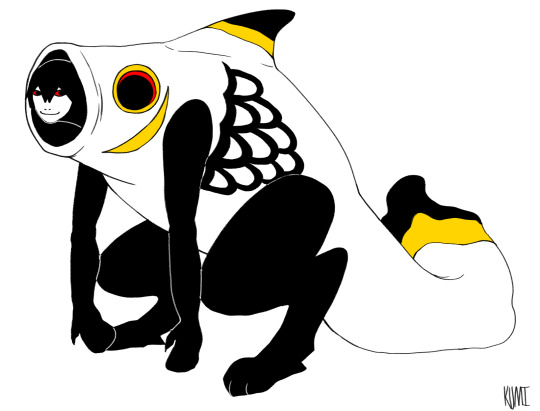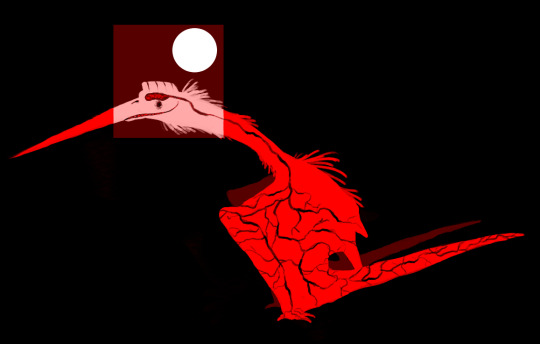Don't wanna be here? Send us removal request.
Text




lets see if we can't make some headway on the flocking backlog... here's from a few weeks back with Triceratops, Helveticosaurus, Dickinsonia, and Melanorosaurus
698 notes
·
View notes
Text
Oc animatic to jack stauber teehee :)
#digital art#creature design#art#artists on tumblr#biology#horror#oc artwork#oc art#oc#original story#horror art#animatic#animation
12 notes
·
View notes
Text


In the end, an audience at all costs.
#digital art#creature design#art#artists on tumblr#horror#npd vent#npd thoughts#vent art#cw gore#cluster b
4 notes
·
View notes
Text
My book BRAMBLE releases this month from Hollowpress.
A 128 page illustrated guide to a roguelike that does not exist.


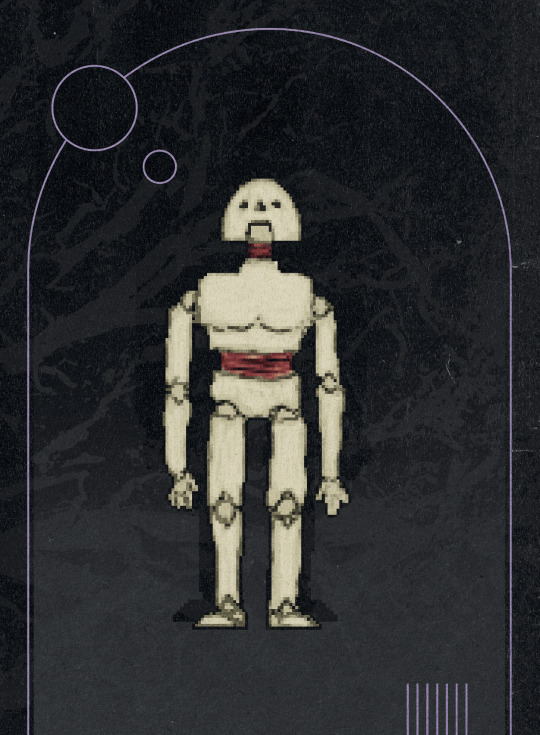
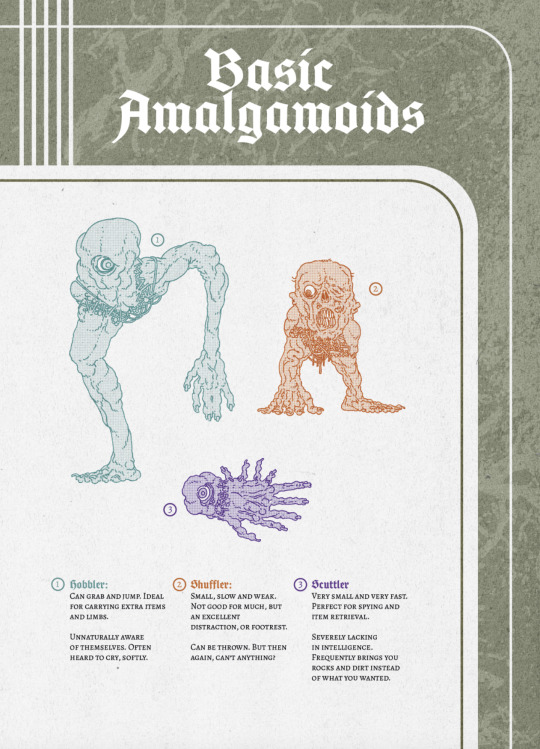




866 notes
·
View notes
Text
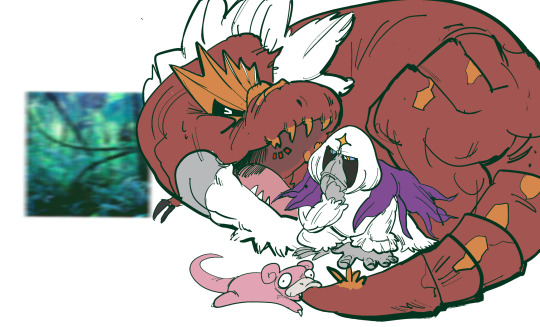



Finally finished the favotire mon drawing :))
#digital art#creature design#artists on tumblr#art#fanart#pkmn fanart#pkmnart#pokemon artist#pokemon#tyrantrum#oranguru#slowpoke#gen 1 pokemon
67 notes
·
View notes
Text

My favorite mons :))
13 notes
·
View notes
Text

Personal project sketch
2 notes
·
View notes
Text
Blind people gesture (and why that’s kind of a big deal)
People who are blind from birth will gesture when they speak. I always like pointing out this fact when I teach classes on gesture, because it gives us an an interesting perspective on how we learn and use gestures. Until now I’ve mostly cited a 1998 paper from Jana Iverson and Susan Goldin-Meadow that analysed the gestures and speech of young blind people. Not only do blind people gesture, but the frequency and types of gestures they use does not appear to differ greatly from how sighted people gesture. If people learn gesture without ever seeing a gesture (and, most likely, never being shown), then there must be something about learning a language that means you get gestures as a bonus.
Blind people will even gesture when talking to other blind people, and sighted people will gesture when speaking on the phone - so we know that people don’t only gesture when they speak to someone who can see their gestures.
Earlier this year a new paper came out that adds to this story. Şeyda Özçalışkan, Ché Lucero and Susan Goldin-Meadow looked at the gestures of blind speakers of Turkish and English, to see if the *way* they gestured was different to sighted speakers of those languages. Some of the sighted speakers were blindfolded and others left able to see their conversation partner.
Turkish and English were chosen, because it has already been established that speakers of those languages consistently gesture differently when talking about videos of items moving. English speakers will be more likely to show the manner (e.g. ‘rolling’ or bouncing’) and trajectory (e.g. ‘left to right’, ‘downwards’) together in one gesture, and Turkish speakers will show these features as two separate gestures. This reflects the fact that English ‘roll down’ is one verbal clause, while in Turkish the equivalent would be yuvarlanarak iniyor, which translates as two verbs ‘rolling descending’.
Since we know that blind people do gesture, Özçalışkan’s team wanted to figure out if they gestured like other speakers of their language. Did the blind Turkish speakers separate the manner and trajectory of their gestures like their verbs? Did English speakers combine them? Of course, the standard methodology of showing videos wouldn’t work with blind participants, so the researchers built three dimensional models of events for people to feel before they discussed them.
The results showed that blind Turkish speakers gesture like their sighted counterparts, and the same for English speakers. All Turkish speakers gestured significantly differently from all English speakers, regardless of sightedness. This means that these particular gestural patterns are something that’s deeply linked to the grammatical properties of a language, and not something that we learn from looking at other speakers.
References
Jana M. Iverson & Susan Goldin-Meadow. 1998. Why people gesture when they speak. Nature, 396(6708), 228-228.
Şeyda Özçalışkan, Ché Lucero and Susan Goldin-Meadow. 2016. Is Seeing Gesture Necessary to Gesture Like a Native Speaker? Psychological Science 27(5) 737–747.
Asli Ozyurek & Sotaro Kita. 1999. Expressing manner and path in English and Turkish: Differences in speech, gesture, and conceptualization. In Twenty-first Annual Conference of the Cognitive Science Society (pp. 507-512). Erlbaum.
84K notes
·
View notes
Photo

IMINT #820 from RASR-2 (USAP)
1. Infinite Truth
561 notes
·
View notes
Text
Deinosuchus: Giant Alligator or something older?
I know the title sucks, I couldn't think of anything poetic or clever ok? Anyways, still catching up on croc papers to summarize and this one did make a few waves when it was published about a week ago.
"Expanded phylogeny elucidates Deinosuchus relationships, crocodylian osmoregulation and body-size evolution" is a new paper by Walter, Massonne, Paiva, Martin, Delfino and Rabi, with quite a few of these authors having considerable experience with crocodile research. The thesis of the study is both simple and unusual. They suggest that several crocodilians traditionally held as stem-alligators, namely Deinosuchus, Leidyosuchus and Diplocynodon, weren't alligatoroids at all. In fact, if the study holds up they might not have been true crocodilians.
Ok, lets take a step back and briefly look at our main three subjects. Deinosuchus of course needs no introduction, a titan of the Cretaceous also known as the terror crocodile in some more casual sources, its easily one of the most iconic fossil crocodiles. It lived on either side of the Western Interior Seaway during the Campanian, fed on giant turtles and dinosaurs and with size estimates of up to 12 meters its easily among the largest crocodylomorphs who have ever lived.
Artwork by Brian Engh

Leidyosuchus also lived during the Campanian in North America and I would argue is iconic in its own right, albeit in a different way. It's historic to say the least and once housed a whole plethora of species, but has recently fallen on hard times in the sense that most of said species have since then been transferred to the genus Borealosuchus.
Artwork by Joschua Knüppe

Finally there's Diplocynodon, the quintessential croc of Cenozoic Europe. With around a dozen species found from the Paleocene to the Miocene all across Europe, it might be one of the most well studied fossil crocs there is, even if its less well known by the public due to its relatively unimpressive size range.
Artwork by Paleocreations

All three of these have traditionally been regarded as early members of the Alligatoroidea, one of the three main branches that form Crocodilia. In these older studies, Alligatoroidea can be broken up into three groups nested within one another. Obviously the crown is formed by the two living subfamilies, Alligatorinae and Caimaninae, both of which fall into the family Alligatoridae. If you take a step further out you get to the clade Globidonta, which in addition to proper Alligatorids also includes some basal forms with blunt cheek teeth as well as Orientalosuchina, tho jury's still out on whether or not they are truly alligator-relatives. And if you take a final step back and view Alligatoroidea as a whole, then you got our three main subjects neatly lined up outside of Globidonta in varying positions.
Below a highly simplified depiction of previous phylogenies. Deinosuchus, Leidyosuchus and Diplocynodon are often regarded as non-globidontan alligatoroids.
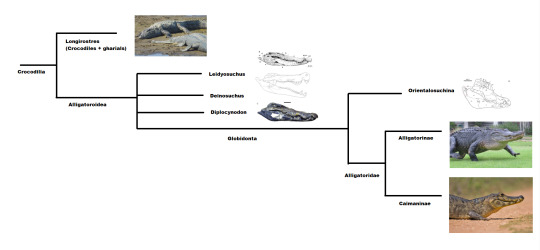
This new study however changes that long standing concensus. The team argues that several features we once thought defined alligatoroids are actually way more common across Crocodilia and even outside of it while also leverging some of the features of Deinosuchus and co. that have always been out of the ordinary. For instance, early alligatoroids are generally characterized as being comparably small, having had short, rounded heads, the afforementioned globular cheek teeth and of course the feature that still allows us to differentiate them from true crocodiles, the fact that they have a clear overbite. Now Leidyosuchus, Deinosuchus and Diplocynodon all have proportionally longer snouts than alligatoroids, their teeth interfinger like in crocodiles and most prominently (and namegiving for Diplocynodon) there is a large notch behind the snout tip that serves to receive two enlarged teeth of the lower jaw. These are of course just superficial examples, but if you wanna get into the nitty gritty check out the paper.
Below a simplified version of the papers phylogeny. Borealosuchus clades with Diplocynodon and Leidyosuchus and Deinosuchus are successive taxa. Planocraniidae are the sister to Crocodilia, which consists of Crocodyloids, Gavialoids (together Longirostres) and Alligatoroids.
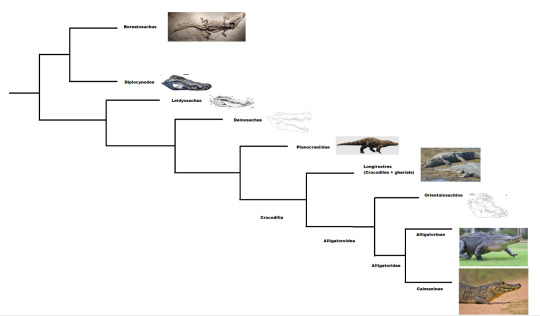
Something also worth addressing in light of these results is salt tolerance in crocodilians and paleogeography. Basically, if you ignore Deinosuchus and co. (or well, just follow this new paper), then it is most likely that alligatoroids originated on the continent of Laramidia, i.e. the western half of America back when it was bisected by an enormous inland sea. Today, alligatoroids are famously intolerant of saltwater, yes, there are instances where alligators have been known to enter coastal waters, but its a far cry from what true crocodiles can achieve (just an example here's my recent post on Caribbean crocodiles). Given that alligatoroids don't appear on Appalachia, the other half of North America, until after the inland sea closes, this very much suggest that this intolerance goes way back. This has however always been at odds with Deinosuchus, which famously showed up along both the eastern and the western coast of the inland sea and at least lived close enough to the coast to leave its mark on the shells of sea turtles. We know it inhabited various near-shore environments and even stable isotope analysis of its teeth points towards it consuming either saltwater or prey that lives in the ocean. To a lesser degree its worth mentioning Diplocynodon, which though usually a freshwater animal has at least one species from coastal deposits. Now I do think its worth highlighting that just being salt tolerant doesn't necessarily mean they can't have been alligatoroids, given that salt glands could have easily been lost after Deinosuchus split off from other alligatoroids. Nevertheless, a position as a stem-crocodilian does add up with it being salt tolerant, with the assumption being that being tolerant to saltwater is basal to crocodilians as a whole and was simply lost in a select few lineages such as alligatoroids.
Given that its range spanned both coastlines of the Western Interior Seaway as well as direct evidence for interactions with marine life, Deinosuchus likely ventured out into the sea from time to time like some modern crocodiles.


There's also the matter of timing. When alligatoroids first appeared 82 million years ago, we already see the classic blunt-snouted morphotype with Brachychampsa and our dear giant Deinosuchus. Now if both were alligatoroids, this would suggest that they've been separate quite some time before that to bring forth these drastically different forms, yet attempts to estimate the divergence date suggest that they split no earlier than 90 million years ago. So if Deinosuchus is not an alligatoroid, then the timeline adds up a bit better. However I think the best example of this new topology really explaining an evolutionary mystery doesn't come from Deinosuchus, but from Diplocynodon. Those that know me might remember that I started working on researching Diplocynodon for Wikipedia, a process that's been slow and painfull both due to the 200 years of research history and the good dozen or so species placed in this genus. Tangent aside, one big mystery around Diplocynodon is its origin. They first appear in the Paleocene and survive till the Miocene, tend to stick to freshwater and oh yeah, species of this genus are endemic to Europe. Given that previous studies recovered them as alligatoroids, nobody was quite sure where Diplocynodon came from. Did they originate in North America and cross the Atlantic? Where they salt tolerant before and simply stuck to freshwater once in Europe? Or are they a much older alligatoroid lineage that entered Europe via Asia after having crossed Beringia. You know, the kind of headbreaking stuff we get when the fossil record is incomplete. But this new study recovers Diplocynodon as being closely related to the non-crocodilian Borealosuchus from the Cretaceous to Paleogene of North America. And that makes some sense, historically the two have been noted to be similar, hell there were even cases when Borealosuchus remains were thought to be North American examples of Diplocynodon. And Borealosuchus has the same double caniniforms as the other crocs we discussed so far. So when our three former alligatoroids got pushed outside of Crocodilia, Diplocynodon ended up forming a clade with Borealosuchus. And since Borealosuchus was wide spread in America by the late Cretaceous, and possibly salt tolerant, then it could have easily spread across Greenland and Scandinavia after the impact, giving rise to Diplocynodon.
The results of this study seem to suggest that Borealosuchus and Diplocynodon are more closely related that previously thought.


And since this is a Deinosuchus paper...of course theres discussion about its size. A point raised by the authors is that previous estimates typically employ the length of the skull or lower jaw to estimate body length, which might not be ideal and is something I definitely agree with. The problem is that skull length can vary DRASTICALLY. Some animals like early alligatoroids have very short skulls, but then you have animals in gharials in which the snout is highly elongated in connection to their ecology. Given that Deinosuchus has a relatively long snout compared to early alligatoroids, size estimates based on this might very well overestimate its length, while the team argues that head width would yield a more reasonable results. Previous size estimates have ranged from as low as 8 meters to as large as 12, which generally made it the largest croc to have ever existed. Now in addition to using head width, the team furthermote made use of whats known as the phylgenetic approach, which essentially bypasses the problem of a single modern analogue with peculariar proportions influencing the result. Now there is a bunch more that went into the conclusion, but ultimately the authors conclude that in their opinion, the most likely length for the studied Deinosuchus riograndensis specimen was a mere 7.66 meters in total length. And before you jump to any conclusions, DEINOSUCHUS WOULD HAVE GOTTEN BIGGER TRUST ME. I know having read "12 meter upper estimate" earlier is quite a contrast with the resulting 7.66 meters, but keep in mind this latter estimate is just one specimen. A specimen that in previous studies was estimated to have grown to a length of somewhere between 8.4 - 9.8 meters. Now yes, this is still a downsize overall, but also given that this specimen is far from the largest Deinosuchus we have, this means that other individuals would have certainly grown larger. Maybe not those mythical 12 meters, but still very large. So please keep that in mind.
Two different interpretations of the same specimen of Deinosuchus. Top a proportionally larger-headed reconstruction by randomdinos, bottom a smaller-headed reconstruction by Fadeno. I do not care to weigh in on the debate other than to say that size tends to fluctuate a lot between studies and that I'm sure this won't be the last up or downsize we see.


Regardless of the details, this would put Deinosuchus in the "giant" size category of 7+ meters, while early alligatoroids generally fall into the small (<1.5 meters) or medium (1.5-4 meters) size categories. The authors make an interesting observation relating to gigantism in crocs at this point in the paper. Prevously, temperature and lifestyle were considered important factors in crocs obtaining such large sizes, but the team adds to that the overall nature of the available ecosystem. In the case of Deinosuchus, it inhabited enormous coastal wetlands under favorable temperature conditions and with abundant large sized prey, a perfect combination for an animal to grow to an enormous size. And this appears to be a repeated pattern that is so common its pretty much regarded as a constant. To quote the authors, "a world with enormous crocodyliforms may have been rather the norm than the exception in the last ~ 130 million years." For other examples look no further than the Miocene of South America, the extensive wetlands of Cretaceous North Africa or even Pleistocene Kenya.
One striking example for repeated gigantism in crocodilians can be found in Miocene South America, when the caimans Purussaurus and Mourasuchus both independently reached large sizes alongside the gharial Gryposcuhus. The illustration below by Joschua Knüppe features some of the smaller earlier members of these species in the Pebas Megawetlands.

So that's it then, case closed. Deinosuchus and co aren't salt-tolerant alligators, they are stem-crocodilians. Deinosuchus was smaller than previously thought and Diplocynodon diverged from Borealosuchus. Leidyosuchus is also there. It all adds up, right? Well not quite. This all is a massive upheaval from what has previously been accepted and while there were outliers before, the alligatoroid affinities of these animals were the concensus for a long time. Future studies will need to repeat the process, analyse the data and the anatomical features and replicate the results before we can be sure that this isn't just a surprisingly logical outlier. Already I heard some doubts from croc researchers, so time will tell if Deinosuchus truly was some ancient crocodilian-cousin or if previous researchers were correct in considering it a stem-alligator. I for one will keep my eyes peeled.
165 notes
·
View notes
Text
"Regicide"

The act of mortally wounding a tyrant lizard king.
A homage to vintage paleoart
Main inspirations were the works of Charles R. Knight & William Stout.
355 notes
·
View notes
Text

'' Various seafaring and ocean-related feathered foes from the known world. 1: Vehe-manta, they're quite big and bold birds of prey with massive razor sharp beaks. They seem quite primitive, and have tiny claws on their wings- makes us even wonder if birds and dragons are the same thing except the later just breathe fire and other hazardous substances. They eat smaller birdies. 2: Shiverbeak turckens, there isnt much to them other than they can be seen across tranquil, clear lakes and lagoons looking for morsels in the cold icy waters, they taste quite good served with tallow and herbs 3: Ringneck gulls, pesky flying rats. If Triton blennies are annoying these are outright disgustingly abundant and obnoxious. All over the seas, all over our decks, and probably making a nest all over our vessels. 4: Diving fiddleloons... not much is known from these big, clumsy birds other than them having long beaks. They appear on our trawl nets sometimes, for the most part? they're seen off in the distance, staring at us whilst we cross their frozen landscape. 5: Sawbill painguins are similar to the Fiddleloons. They live colonies across frozen ice caps and glaciers, sometimes in rocky shores aswell. Their beaks make for excellent saws, swinging them side to side whenever it comes to feeding or defending themselves. 6: Abominable snowpoffs, they run fast with their spindly legs avoiding the rising tides. Whatever washes ashore is fair game for them, worms and all that kind of gunk. We thought they had a neck but apparently they're just like that, poffy and rotund 7: Damned Tidestompers. Sometimes i wonder what was the thought procress behind this feathery critter... They live amongst snowpoff colonies! despite their size and long (yet not so visible necks, they only extend them when needed), Tidestompers only pick up snails and small mussels on the surf zone, they dont seem to like eating other birds... i guess. Using their big wide feet, they anchor themselves in the sand before they get swashed by the crashing waves. ''
914 notes
·
View notes

